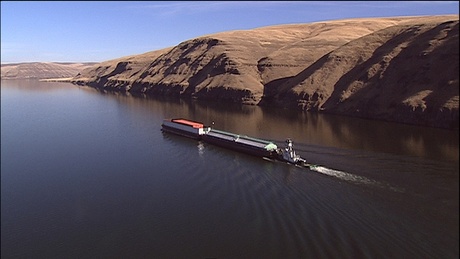forum
library
tutorial
contact

Activists Oppose Dredging Plan
by Eric BarkerLewiston Tribune, March 27, 2013
|
the film forum library tutorial contact |

|
Activists Oppose Dredging Planby Eric BarkerLewiston Tribune, March 27, 2013 |
U.S. Army Corps of Engineers hears objections to its plan to dredge lower Snake River navigation channel
 The U.S. Army Corps of Engineers has received hundreds of comments on its plan to dredge the lower Snake River, including a salvo from environmentalists attacking everything from its economics to its core assumptions.
The U.S. Army Corps of Engineers has received hundreds of comments on its plan to dredge the lower Snake River, including a salvo from environmentalists attacking everything from its economics to its core assumptions.
A coalition - including several environmental groups, Kooskia residents Linwood Laughy and Borg Hendrickson and fishing organizations - alleges the corps was wrong to conclude it is required by Congress to maintain the navigation channel at a depth of 14 feet and width of 250 feet. Coalition members say that assumption caused the agency to dismiss alternatives that did not include dredging and unnecessarily constrained the range of options it did consider.
"Dredging is a foregone conclusion," they wrote in more than 50 pages submitted to the corps.
Instead, they said the plan should have considered things like light-loading barges, not shipping year-round or alternatives to barging such as rail.
"The corps' failure to give detailed consideration to any alternative that does not rely on dredging is fatal to the legality of its (National Environmental Policy Act) analysis," according to their comments.
Tuesday was the deadline for people to submit comments on the agency's draft programmatic sediment management plan, which outlines ways to deal with the accumulation of sediment in the lower Snake River near Lewiston. That plan, which cost $16 million to develop, calls for dredging as soon as next winter to restore the navigation channel to dimensions authorized by Congress. It also outlines a menu of other actions that may be taken if future sediment accumulation threatens the navigation channel, fish and wildlife habitat, or recreation sites, or if it increases the risk of flooding at Lewiston.
Corps spokesman Bruce Henrickson said the agency had received in excess of 200 comments as of last week, but also noted many are similar in nature.
"It's possible the total may go significantly higher than that," he said.
Many who attended a corps-hosted meeting held in January at Lewiston to discuss the sediment plan complained dredging is too expensive and asked for an analysis of the cost of dredging versus the economic activity generated by barge transportation.
Henrickson said the corps did not write a cost-benefit analysis because dredging is the only identified short-term action that can restore the navigation channel.
"There is not a cost to compare it to," he said.
The comments submitted by the coalition included analysis by Laughy and work by economist Ernie Niemi of Natural Resource Economics Inc., which concludes dredging could cost $39 million over 10 years.
Related Pages:
Energy Intensities of Freight: Barge, Truck and Railroad US Department of Energy, Transportation Energy Data Book
learn more on topics covered in the film
see the video
read the script
learn the songs
discussion forum
